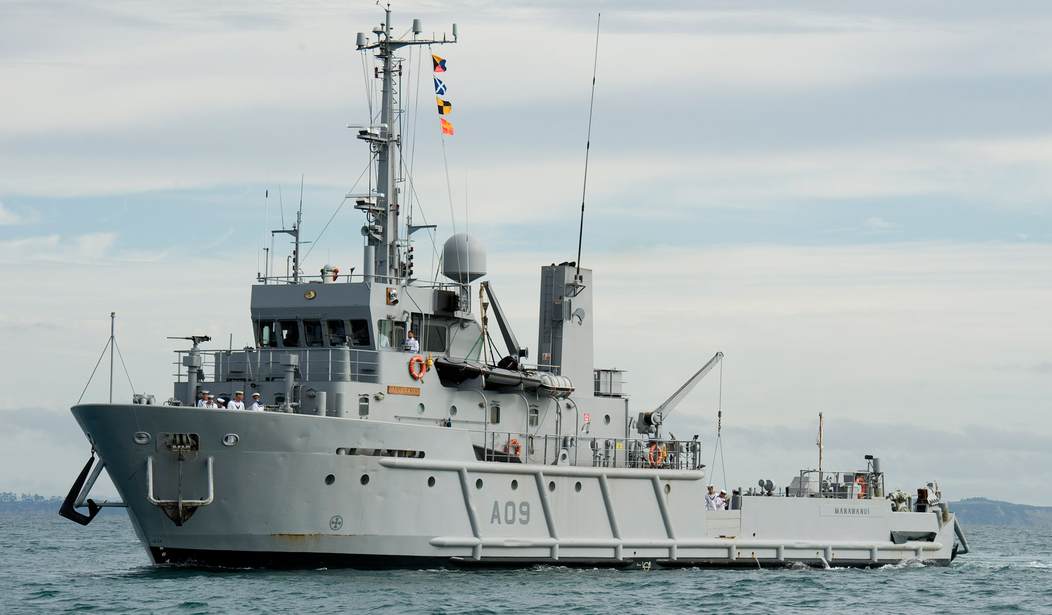On Sunday, the HMNZS Manawanui, a $100 million New Zealand Navy survey and hydrograpic vessel, caught fire and sank after running aground on a reef off the coast of Samoa.
It's the first Navy vessel lost by New Zealand since WWII. Thankfully, the 75 crew and passengers were safely evacuated and rescued, although several injuries were reported.
All 75 crew and passengers onboard were safely rescued overnight. Two people needed hospital treatment for minor injuries, one with a dislocated shoulder and another with a hurt back.
— Lord Bebo (@MyLordBebo) October 6, 2024
"Rescuers battled currents and winds that were pushing the life rafts and sea boats toward the… pic.twitter.com/gRLnCs5qG0
The New Zealand Defense Force said, "Rescuers battled currents and winds that were pushing the life rafts and sea boats toward the reefs, and swells made the rescue effort particularly challenging."
"At this stage the exact cause of the grounding is unknown and this will need further investigation," the NZDF statement said. "At 6.40am Sunday, the ship was listing heavily and smoke was visible from the ship. At 9.00am it was known to have capsized and was below the surface. The NZDF is working with authorities to understand the implications and minimise the environmental impacts."
A Court of Inquiry is looking into the incident, and "the New Zealand response was focused on supporting the Samoan Government to understand possible environmental impacts from the incident and reduce those as much as possible, with teams from across multiple agencies involved."
The Court of Inquiry needs to look into what role, if any, NZDF's aggressive "diversity" policies played in the ship's sinking. The ship's commanding officer was Commander Yvonne Gray, a British woman who moved to New Zealand in 2012 with her lesbian "wife." Gray had served in the British Navy since 1993 before joining the New Zealand Navy.
In a New Zealand Reddit forum, some have accused Gray of "jumping the line."
"She could be the best commander weve ever had, but in my eye shes still scum for cutting in line," one contributor noted. "How the f**k are we supposed to encourage people to take up a career in the navy or other armed forces branches, when you get foreign transfers cutting in across the top of local career officers and taking plum jobs like Captain. There's people in the service for decades that would have seen their career progression hopes dashed, because some English officer came here on a holiday, thought it was lovely and in less than 5 years is given command of our third biggest and newest ship." [Typos original]
Another pointed out that she may have been allowed to "cut in line" due to military retention problems.
The NZDF's website, ablaze with rainbow flags, notes:
The New Zealand Defence Force's active commitment to building a diverse and inclusive workplace is part of our drive to keep our people well, included, respected, enabled and safe so they can do their job to the best of their ability, have a fulfilling career and ultimately, contribute to a high performing Defence Force.
The benefits of increasing the diversity of our workforce and inclusion of all people include ensuring we can:
- compete to attract and keep New Zealand’s most talented people from the widest talent pool possible
- seize the ‘cognitive edge’ through our agile thinking and innovative problem solving (leading to greater operational effectiveness)
- ensure support from the people we work amongst nationally and internationally to work closely and professionally together as one force.
Did Gray get promoted and commissioned as captain of the ship in order to satisfy diversity requirements? Don't hold your breath waiting for an investigation into that possibility.
The New Zealand incident brings to mind the USS Fitzgerald crashing into a container ship off the coast of Japan in 2017 under the leadership of a young female officer.
The collision of the vessels was the Navy’s worst accident at sea in four decades. Seven sailors drowned. Scores were physically and psychologically wounded. Two months later, a second destroyer, the USS John S. McCain, broke that grim mark when it collided with another cargo vessel, leaving 10 more sailors dead.
The successive incidents raised an unavoidable question: How could two $1.8 billion Navy destroyers, protected by one of the most advanced defense systems on the planet, fail to detect oncoming cargo ships broadcasting their locations to a worldwide navigational network?... The failures of basic seamanship deeply embarrassed the Navy. Both warships belonged to the vaunted 7th Fleet — the most powerful armada in the world and one of the most important commands in the defense of the United States from nuclear attack.
Petty Officer 1st Class Samuel Williams noticed Nelson struggling. He took control of the helm and did as Coppock ordered: He pushed the throttle to full and turned the rudder hard left. The ship’s engines revved to full power.
The move put the Fitzgerald directly into the path of the oncoming Crystal.
Coppock did not sound the collision alarm to warn sailors of the impending risk.
“I just got so wrapped up in trying to do anything that I had to just drop the ball on everything else that I needed to do,” she said.
It was later determined that Sarah Coppock, the 26-year-old officer of the deck, who was in charge of the destroyer at the time of the crash, "In a panic... ordered the Fitzgerald to turn directly into the path of the Crystal." According to shipmates, Coppock was standoffish and refused to dine with her fellow sailors.
"Sixteen minutes after the collision, at 1:46 a.m., [Navy Cmdr. Bryce] Benson [who was asleep at the time of the crash] staggered onto the bridge," the report continued. "Adrenaline, fear and anger shot through him. The ship was listing, wheeling in the dark uncontrolled. The electricity was out. The screens were off. Only emergency lanterns and moonlight illuminated the bridge."
Benson found Coppock "sobbing."
“Captain, I f**ked up,” she told him.
"The Navy’s investigators concluded that sailors bore the primary blame for the collision," ProPublica reported. "Benson, Coppock and the bridge and combat information center watch teams had failed to use basic seamanship skills to escape an “avoidable” accident. They had been “excessively fatigued” and had not taken steps to rest. Coppock had ignored basic rules of the road and the captain’s orders.
Coppock ultimately pled guilty to one count of negligence in a 2018 court-martial proceeding and was reprimanded and sentenced to three months reduced pay.










Join the conversation as a VIP Member